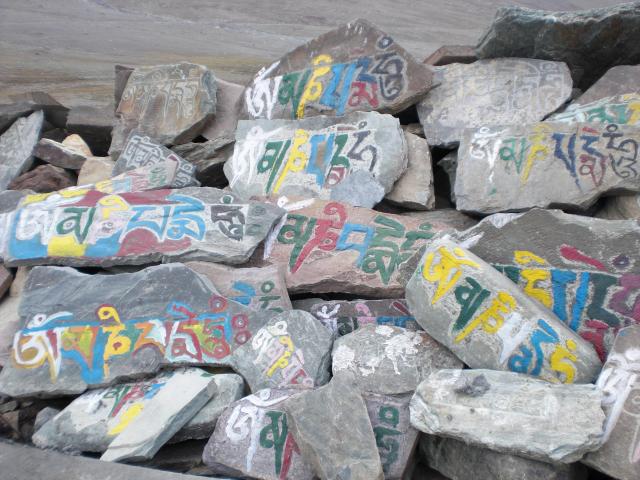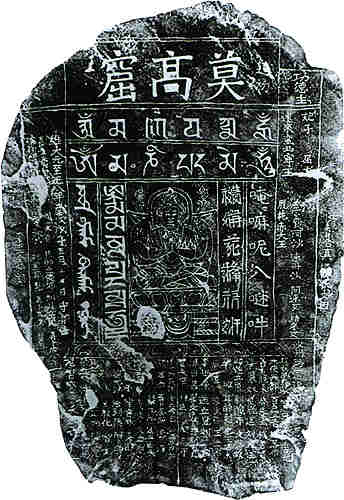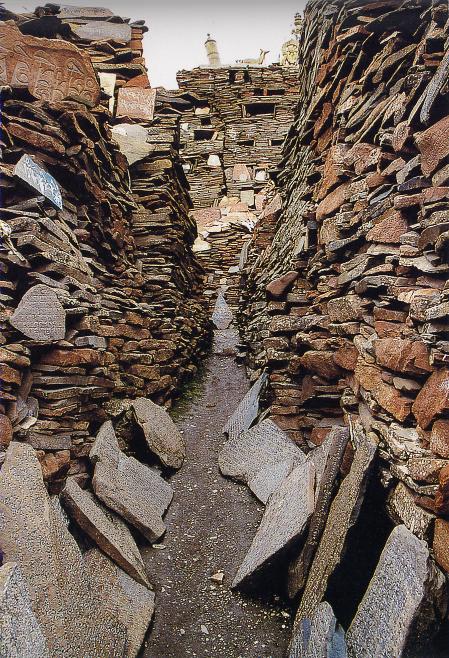BabelStone Blog
Sunday, 5 November 2006
Mani Stones in Many Scripts
Mani stones are stones that are carved with the famous Sanskrit mantra oṃ maṇi padme hūṃ, which is known periphrastically as the "six-syllable mantra" (liùzì zhēnyán 六字真言 in Chinese and yi ge drug pa in Tibetan). The origins of the mantra are obscure, but it is normally associated with the bodhisattva Avalokiteśvara (Tibetan spyan ras gzigs "Chenrezig"), particularly his four-armed manifestation, Shadakshari ("Lord of the Six Syllables"); although it has been suggested that it was originally an invocation to a female consort of Avalokiteśvara called Manipadma (see this Early Tibet post for a discussion of the limited association of six-syllable mantra with Avalokiteśvara in early Tibet).
It is not known when the mantra came into use, but it must have been long before the earliest recorded mentions of it in the late 10th and early 11th centuries. By the time of the rise of the Mongol empire in the 13th century the use of this mantra was already widespread, and had attracted the attention of European visitors to China, such as William of Rubruck, who has this to say about Buddhist practice in the account of his travels to the East between 1253 and 1255 :
All the priests shave their heads, and are dressed in saffron color, and they observe chastity from the time they shave their heads, and they live in congregations of one or two hundred. On the days when they go into the temple, they place two benches, and they sit in the region of the choir but opposite the choir, with books in their hands, which they sometimes put down on these benches; and they keep their heads uncovered as long as they are in the temple, reading in silence and keeping silence. And when I went into one of their temples at Caracarum, and found them thus seated, I tried every means of inducing them to talk, but was unable to do so. Wherever they go they have in their hands a string of one or two hundred beads, like our rosaries, and they always repeat these words, on mani baccam, which is, "God, thou knowest," as one of them interpreted it to me, and they expect as many rewards from God as they remember God in saying this.
In Tibet the six-syllable mantra is to be found everywhere, on prayer flags and on prayer wheels, but most spectacularly carved onto the rocks and stones that decorate the landscape. The picture below is a mani stone in Tibetan script from the Russian Far East (courtesy of Vladimir Belyaev) :
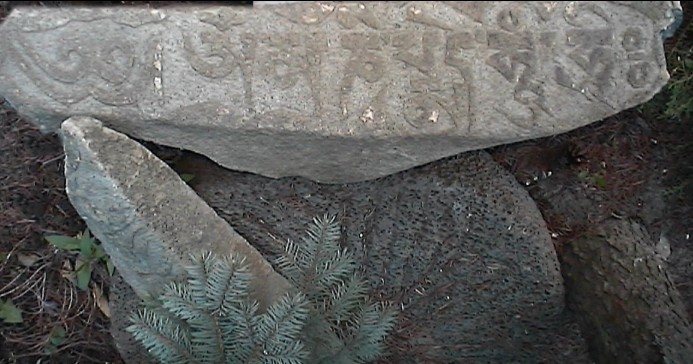
The inscription here is terminated with the seed syllable hrī (as is often the case with Tibetan inscriptions) :
༄༅།ཨོཾ་མ་ཎི་པདྨེ་ཧཱུཾ་ཧྲཱི༔
The main formula is often painted over in colour, as on these examples on the Kunzum Pass above the Spiti Valley in India (photograph courtesy of Konstantin Shemyak) :
Note that each syllable of the formula is painted in its own particular colour (and that the "d" of pad has the same colour as the rest of the syllable, even when it is stacked onto the following syllable me) :
- ཨོཾ་ : white
- མ་ : green
- ཎི་ : yellow
- པད་ : light blue
- མེ་ : red
- ཧཱུཾ་ : dark blue
Here is my attempt to display the six syllables in their six colours as text. I have had to write pad and me separately (as they less commonly are), as I don't think it is possible to colour the individual components of a single dme glyph in different colours.
| ཨོཾ་ མ་ ཎི་ པད་ མེ་ ཧཱུཾ་ |
Although Tibetan script mani stones are most frequently encountered, the mani formula may also be engraved using the Ranjana or Rañja or Lantsa script (lan tsha, lan dza or la nya tsha in Tibetan). This a woodblock print showing how the six-syllable mantra is written in the Lantsa script :

Nik Douglas, Tibetan Tantric Charms & Amulets (Dover Publications, 1978) No.29.
And here is an example from the British Museum of a stone with the Mani formula written five times in the Lantsa script :
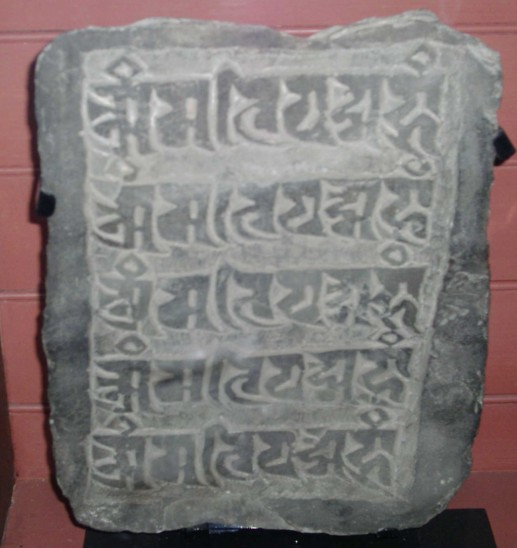
Closely related to Lantsa is the Vivarta or Wartu script (Tibetan war tu or war tu la). The inscription beneath the image of Shadakshari (the four-armed manifestation of Avalokiteśvara) on this stone is in the Wartu script (note how the form of the syllable oṃ differs markedly from Lantsa but is very similar to oṃ in the Siddham script) :
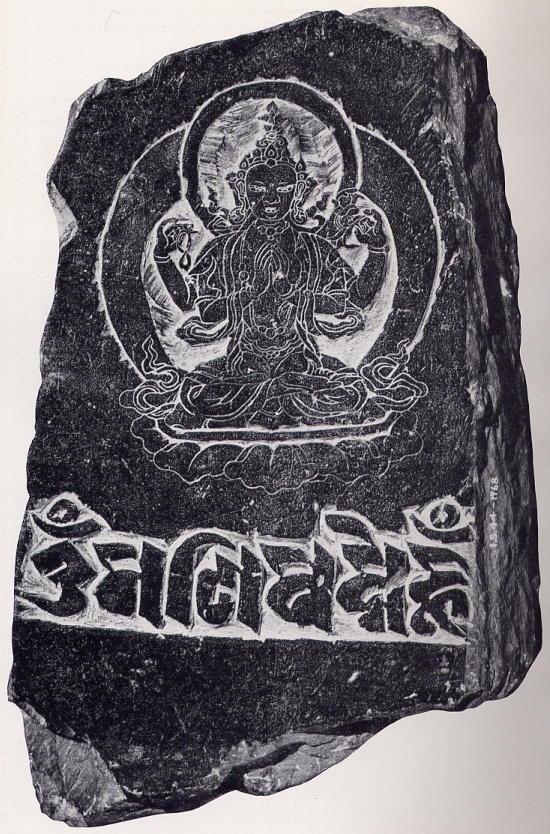
John Lowry, Tibetan Art (London: Her Majesty's Stationery Office, 1973) plate 49.
Whilst mani stones in Tibetan, Lantsa or Wartu scripts are most common, the mani formula may also be written in a variety of other scripts, and I thought it would be interesting to collect examples of the six-syllable mantra in as many scripts as possible, a sort of I can eat glass project for Buddhist epigraphers.
The best example of a multi-script mani stone that I know of is the 1348 Stele of Sulaiman, which was found at Mogaoku 莫高窟 (i.e. the Caves of the Thousand Buddhas) at Dunhuang in the late 19th century (click on the picture below to link to a higher resolution picture from a marvellous exhibition of documents relating to the scripts and languages of the ancient nationalities of China at the National Library of China) :
This monument was erected during the Yuan dynasty, in the 8th year of the Zhizheng period [1348], by Sulaiman 速來蠻, who was the Prince of Xining 西寧王 from 1329 to his death in 1351. The inscription includes the six-syllable mantra written in six different scripts (is the number of scripts chosen a coincidence? — probably not; the same six scripts are also found on the 1342 Cloud Platform at Juyongguan) :
- Lantsa (梵文) [1st row] oṃ ma ṇi pa dme hūṃ
- Tibetan [2nd row] : oṃ ma ṇi pad me hūṃ ཨོཾ་མ་ཎི་པད་མེ་ཧཱུྃ
- Old Uyghur (回鹘文) [far left] : oom mani badmi xung 𐽰𐽳𐽳𐽹 𐽹𐽰𐽺𐽶 𐽼𐽰𐽸𐽹𐽶 𐽲𐽳𐽺𐽷
- 'Phags-pa (八思巴文) [left] : ’om ma ni pad me hung ꡝꡡꡏ ꡏ ꡋꡞ ꡌꡊ ꡏꡠ ꡜꡟꡃ
- Tangut (西夏文) [right] : ·a mja nji pja mjij xo 𗙫𗏵𗐱𗴟𗘺𗦀
- Chinese [far right] : ǎn má ní bā mí hōng 唵嘛呢叭𠺗吽
For anyone who thought that there was nothing more to add to Unicode, it is a sobering thought that three of these six scripts are as yet unencoded (although Tangut is now in the process of being encoded) and one ('Phags-pa) was only just introduced in Unicode 5.0 a couple of months ago, and so it is currently not possible to represent the text of this important monument in Unicode. [Tangut was eventually encoded in Unicode v. 9.0 in June 2016]
Another extinct and as yet unencoded script that the mani formula has been written in is Jurchen (女真文). The illustration below (apologies for the poor quality) is from an early Ming dynasty stone monument commemorating the founding of the Yongning Temple 永寕寺 in the 11th year of the Yongle period [1413] in the district of Nurgan, located near the mouth of the Amur River in what is now part of Russia (the actual monument is in the Vladivostok Museum).
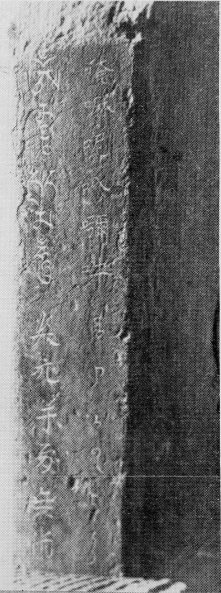
Jin Guangping 金光平 and Jin Qizong 金啓孮, Nüzhen Yuyan Wenzi Yanjiu 女真語言文字研究 (Beijing: Wenwu Chubaneshe, 1980).
The main text is inscribed in Chinese on the front and in Mongolian and Jurchen on the back, but on both sides of the monument the six-syllable mantra is engraved in the following four scripts :
- Tibetan [top left] : oṃ ma ṇi pad me hūṃ ཨོཾ་མ་ཎི་པད་མེ་ཧཱུཾ
- Jurchen [bottom left] am ma ni ba mi xu
- Chinese [top right] : ǎn má ní bā mí hōng 唵嘛呢叭𡄣吽
- Mongolian [bottom right] : oom ma ni bad mi qung ᠣᠣᠮ ᠮᠠ᠋ ᠨᠢ ᠪᠠᠳ ᠮᠢ ᠬᠤᠩ
Notes
Tibetan
The mantra is normally written with padme as one word, but it may be written as two words (pad me), as in the 1348 and 1413 inscriptions shown above. In modern Lhasa Tibetan the mantra is pronounced om mani peme hung.
Here are some links to a few more images of Tibetan mani stones (just a few of the many you can find with the help of Google Image Search) :
- Prayer-stone from a Tibetan mountain-pass (Ladakh) at the British Museum
- Mani stone from Nepal
- Mani stone in Nepal
- Mani stone in Tibet
- Coloured mani stone
- Mani stone in Ladakh with Tibetan and Lantsa inscription
- A pile of mani stones
- Mani stones in Zanskar
Lantsa, Wartu and Siddham
Lantsa (Ranjana), Wartu (Vivarta) and Siddham (Chinese xītán 悉曇 or 悉檀) are three closely related scripts, and from a character encoding point of view they could be considered to be variant styles of the same basic script.
'Phags-pa
The 'Phags-pa text in the 1348 Mogaoku inscription follows the Tibetan spelling convention of using a dependant vowel sign to write om, but Mongolian and Chinese 'Phags-pa texts use an independant letter o. For example, in the 1345 'Phags-pa inscriptions at Juyongguan 居庸關 the mantric syllable oṃ in the invocation oṃ bhrūṃ [bhrūṃ bhrūṃ] (from the Sanskrit Phags-pa inscription on the west wall) and the invocation om sva sti (from the start of the Mongolian Phags-pa inscription on the east wall) is written with an independant letter rather than with a dependant vowel sign, but whereas the Sanskrit text (on the left) uses a candrabindu letter, the Mongolian text (on the right) represents the final nasal with a simple letter m :
![oṃ bhrūṃ [bhrūṃ bhrūṃ]](http://BabelStone.co.uk/Blog/Images/om_bhrum.jpg)

Chinese
The mantra is normally transcribed using the Chinese characters :
- 唵 ǎn or 嗡 wēng
- 嘛 má
- 呢 ní
- 叭 bā, 吧 bā or 唄 (呗) bài
- 咪 mí, 𠺗 mí, 𡄣 (𠵸) mí or 彌 (弥) mí
- 吽 hōng
There are thus a wide range of possible transcriptions of the mani formula in Chinese, including :
- 唵嘛呢叭咪吽 ǎn má ní bā mí hōng
- 唵嘛呢叭𠺗吽 ǎn má ní bā mí hōng
- 唵嘛呢叭彌吽 ǎn má ní bā mí hōng
- 唵嘛呢叭𡄣吽 ǎn má ní bā mí hōng
- 唵嘛呢吧咪吽 ǎn má ní bā mí hōng
- 唵嘛呢吧彌吽 ǎn má ní bā mí hōng
- 唵嘛呢唄咪吽 ǎn má ní bài mí hōng
- 唵嘛呢唄彌吽 ǎn má ní bài mí hōng
- 唵嘛呢唄咪吽 ǎn má ní bài mí hōng
- 嗡嘛呢叭咪吽 wēng má ní bā mí hōng
- 嗡嘛呢叭彌吽 wēng má ní bā mí hōng
- 嗡嘛呢唄咪吽 wēng má ní bài mí hōng
- 嗡嘛呢唄彌吽 wēng má ní bài mí hōng
However, the mantra is sometimes written in a somewhat different way, as is the case on this undated bronze plaque devoted to the goddess Cundi (Chinese Zhunti 凖提) (the inscription on the reverse is in the Lantsa script) :
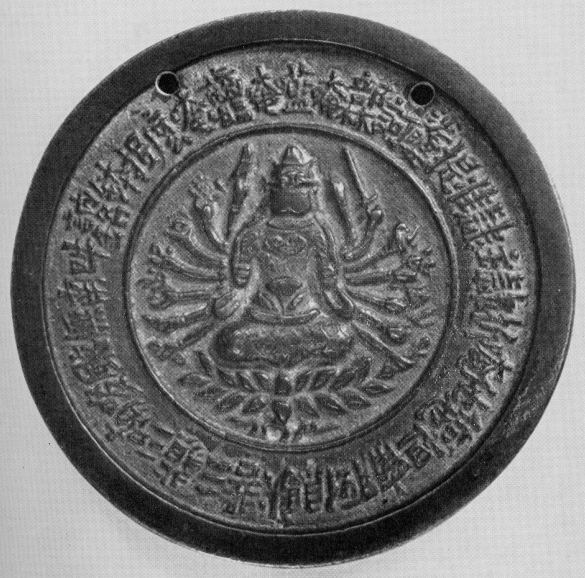
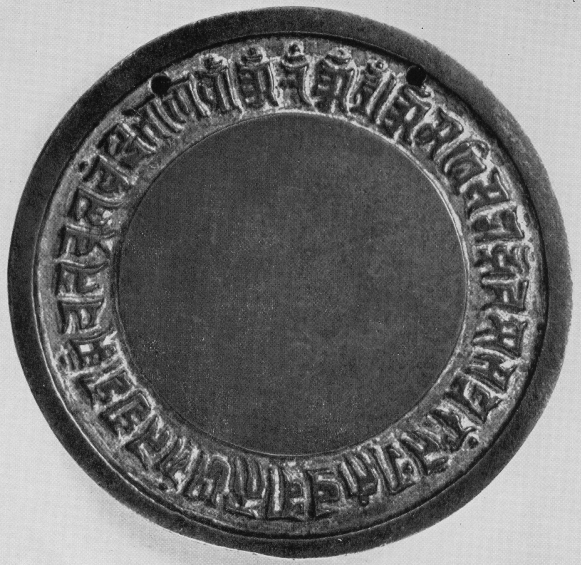
Here (reading anticlockwise from 11 o'clock) the mantra is written with the characters 唵麽呢鉢訥銘吽 ǎn má ní bō nàmíng hōng, where 訥銘 nàmíng (written one character above the other) transcribes the dme of padme. Although using na for /d/ may seem odd, this corresponds to early Chinese Sanskrit transcription practice, as can be seen in this mid fourteenth century book by Tao Zongyi 陶宗儀, where Sanskrit /d/ is transcribed as nà 捺 :

Shushi Huiyao 書史會要 vol. 8 folio 6b.
A final note on the character 吽 hōng that is used to transcribe hūṃ. The first five characters of the mani formula in Chinese (唵嘛呢叭咪吽) are each written using a mouth radical on the left to indicate that the element on the right is being borrowed as a phonetic approximation, but the last character is written with a mouth radical on the left and the character for an ox (níu 牛) on the right, which is not in this case a phonetic. The Tang dynasty monk Huilin 慧琳 (737-820) explains the character 吽 hōng thus : "It is like the sound of an ox bellowing, or perhaps an angry tiger; the sound comes from deep within the throat" (如牛吼聲,或如虎怒,胸喉中聲也).
Jurchen
The six characters of the mantra in the 1413 inscription are all easily identifiable.
| Character* | Reading** | Nüzhenwen Cidian | Grube 1896 | Nüzhen Yiyu 女真譯語 Phonetic Gloss |
|---|---|---|---|---|
| 嗆 | am | p.293 | #474 | 安 |
| 丵 | ma | p.10 | #370 | 馬 |
| 喒 | ni | p.287 | #560 | 你 |
| 侠 | ba | p.56 | #419 | 巴 |
| 剣 | mi | p.175 | #641 | 迷, 密 |
| 儂 | xu | p.111 | #385 | 忽, 戶, 琥, 瑚 |
* Characters are displayed using Jason Glavy's Jurchen font. If you do not have this font installed you will see Chinese characters instead.
** The readings are the phonetic reconstructions of Jin Guangping 金光平 and Jin Qizong 金啓孮 in Jin Qizong 金啓孮, Nüzhenwen Cidian 女真文辞典. Beijing: Wenwu Chubanshe, 1984.
Tangut
The Tangut characters for the first five syllables of the mantra in the 1348 inscription are easily identifiable, but the sixth character is not to be found in Li Fanwen's Tangut-Chinese dictionary, and I was originally unable to identify it. However, now that I have been given a copy of Wenhai Yanjiu 文海研究 I have been able identify the character in the inscription as a variant form of the Tangut character specifically used for transliterating Sanskrit hūṃ. Notice how the four-stroke element on the right side has been simplified to 干 in the 1348 inscription.
| Character | Reading* | Xia-Han Zidian |
|---|---|---|
| 𗙫 | ·a | #0774 |
| 𗏵 | mja | #3369 |
| 𗐱 | nji | #4884 |
| 𗴟 | pja | #3425 |
| 𗘺 | mjij | #0201 |
| 𗦀 | xo | #2224 |
* The readings are the phonetic reconstructions given in Li Fanwen 李範文, Xia-Han Zidian 夏漢字典 [A Tangut-Chinese Dictionary] (Beijing: Zhongguo Shehui Kexue Chubanshe, 1997).
The first and last characters in the mantra are defined in the mid 12th century monoglot Tangut Rhyming dictionary, The Sea of Characters 文海. The original Tangut text and Chinese translation as given in Wenhai Yanjiu 文海研究 (Zhongguo Shehui Kexue Chubanshe, 1983) by Shi Jinbo 史金波 et al. is shown below :£
 |
 |
|
襍9-151 譯音字[唵] [音]左[詔]全 此者經典真言中用梵語是也。 |
襍9-152 譯音字[吽] [心]左[勿]右 此者經典真言中用梵語是也。 |
There is also a bronze mirror with the image of a Buddha surrounded by the the mani formula in Tangut script. I haven't got a good picture of it, but you can buy a replica of it from 宁夏特产网 (you can also buy a set of replica Tangut coins if you want). Meanwhile here is a copy of the inscription of the mirror given in the 1935 edition of Yin Tong 音同 "Homophones".

𗙫𗏵𗐱𗴟𗘺𗦀𗙫𗠝𗦀
·a mja nji pja mjij xo, ·a ·a xo
唵嘛呢叭𠺗吽唵阿吽 ǎn má ní bā mí hōng, ǎn ā hōng
Old Uyghur
My transcription of the Old Uyghur text of the 1348 inscription is tentative.
Mongolian
The Mongolian text on the 1413 Yongning Temple monument is far from clear, and my transcription is tentative only. However, there are clear similarities to the Old Uyghur version of the mantra with respect to spelling.
In more recent Mongolian texts the six-syllable mantra is spelled very differently from the 1413 inscription, and makes use of a special candrabindu sign. I haven't got an image of a Mongolian script mani stone yet, but in the meantime I have included an entry in the table for how I think the mantra should be written in standard Mongolian script (cf. the representation of the six-syllable mantra on a bronze incense burner in front of the Gandan Monastery in Ulaanbaatar shown on page 8 of Oliver Corff's MonTEX, A Quick Guide).
I can think of several more scripts (Manchu, Khitan, Soyombo, Siddham, Kharoshthi, Tocharian, Orkhon ...) that may have been used to write Buddhist mantras, so feel free to send me examples of mani stones in other scripts and I will update this page.
Last modified: 2023-09-29 (updated with Unicode Old Uyghur and Siddham characters)
CJK | Jurchen | Mongolian | Phags-pa | Tangut | Tibetan | Inscribed Stones
Index of BabelStone Blog Posts
